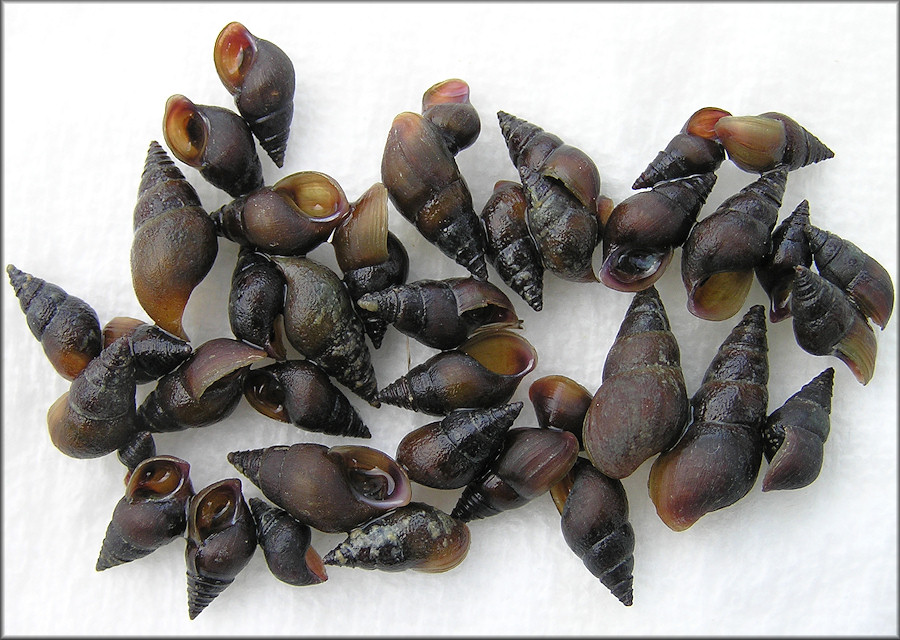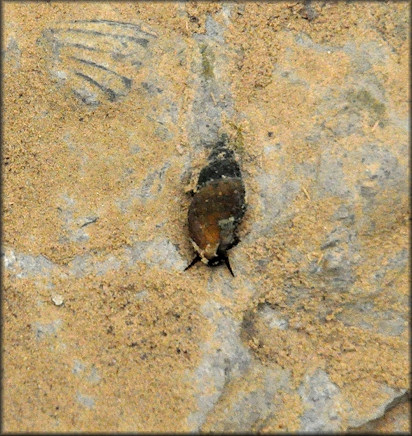|
Pleurocera semicarinata (Say, 1829) Fine-ridged Elimia |
|
|
|
On stream bed in 3-4 inches of water, Sunfish Creek, eastern Nelson Co., Kentucky 2/16/2013. Collected by Lori Schroeder. |
|
|
|
On
stream bed, Sunfish Creek, eastern Nelson Co., Kentucky
3/22/2013
|
|
A commentary on the taxonomy and nomenclature of the type genus of Pleuroceridae [verbatim from Dillon, 2011:* 276, 277] The taxonomy of the Pleuroceridae was entirely unstable throughout the nineteenth century, hundreds of species being described and dozens of genera being proposed to contain them (Tryon, 1873). Modern workers have generally recognized seven or eight North American genera, but have often selected different nineteenth-century names to call them. Walker (1918) preferred Io, Lithasia, Gyrotoma, Eurycaelon, Anculosa, Goniobasis and Pleurocera. Goodrich (1924, 1940) split Nitocris from Anculosa but otherwise followed closely: Io, Lithasia, Gyrotoma, Eurycaelon, Anculosa, Nitocris, Goniobasis, and Pleurocera. Morrison (1954) considered that Rafinesque’s nomen “Pleurocera” was more correctly applied to the group that Walker termed “Lithasia,” and that the Rafinesque nomen “Oxytrema” was better applied to a combination of Walker’s Pleurocera and Goniobasis. He also preferred Leptoxis over Anculosa, and split the genus referred to as “Nitocris” by Goodrich into Mudalia and Anaplocamus. The result again yielded eight genera: Io, Pleurocera, Gyrotoma, Eurycaelon, Leptoxis, Mudalia, Anaplocamus, and Oxytrema. Burch & Tottenham (1980) returned to the Walker/Goodrich concept of Pleurocera, anticipating Opinion 1195 of the ICZN (Melville, 1981). Burch subsumed Eurycaelon, Mudalia,and Anaplocamus of Morrison under the single genus Leptoxis, preferred Elimia over Goniobasis, and split out the western Juga, yielding: Io, Lithasia, Gyrotoma, Leptoxis, Juga, Elimia, and Pleurocera. The research results presented in the main body of the present work demonstrate that the shell characters by which Walker, Goodrich, and Burch distinguished Pleurocera from either Goniobasis or Elimia do not rise to the level of the genus. Hence, these two groups should be combined, as preferred by Morrison. But following Opinion 1195, the oldest available name of the combined group is not Oxytrema, but rather Pleurocera, as follows:Family Pleuroceridae Fischer, 1885 Genus Pleurocera Rafinesque, 1818 Pleurocera Rafinesque, 1818: 355. Type species, Pleurocerus acutus Rafinesque in Blainville, 1824. Opinion 1195 of the ICZN (Melville, 1981). Oxytrema Rafinesque, 1819: 423, genus without species. Type species, P. acutus Rafinesque, by subsequent monotypy by Blainville (Morrison, 1954: 360). Ceriphasia Swainson, 1840: 204. Type species, C. sulcata Swainson, 1840, by monotypy. Telescopella Gray, 1847: 153. Type species, Melania undulata Say, 1829, by original designation. Elimia H. Adams & A. Adams, 1854: 300. Type species Melania acutocarinata [I.] Lea, 1841, by subsequent designation of Pilsbry & Rhoads (1896). Melasma H. Adams & A. Adams, 1854: 300. Type species Melania laqueata Say, 1829, by subsequent designation of Baker (1963). Strephobasis [I.] Lea, 1861: 96. Type species Melania plena Anthony, 1854, by subsequent designation of Pilsbry & Rhoads (1896). Trypanostoma [I.] Lea, 1862: 169. Type species Melania canaliculata Say, 1821, by original designation. Goniobasis [I.] Lea, 1862: 262. Type species, G. osculata [I.] Lea, 1862, = Melania olivula Conrad, 1834, by subsequent designation of Hannibal, 1912. Macrolimen [I.] Lea, 1863: 220. Type species Melania showalterii [I.] Lea, 1862, by monotypy. Strepoma Haldeman, 1863: 274, ex Rafinesque ms. Type species, Melania canaliculata Say, 1821. Diagnosis: A genus in the freshwater Cerithiacean [sic] family Pleuroceridae with elongate, conic, or cylindrical shells, often carinate or costate but not spinose or (ordinarily) pustulate. Aperture may be notched anteriorly, but never posteriorly. Dioecious, sexually reproducing. Differring [sic] from the similar Juga by the absence of a seminal receptacle (Strong & Frest, 2007). Description: See Strong (2005) for a thorough description of P. acuta and E. livescens. All differences noted between those two taxa are here considered significant only at the specific level, not at the level of genus. Distribution and Habitat: Found in freshwater habitats through much of eastern North America, from northern Florida to southern Ontario, west to Texas and Minnesota. Primarily an inhabitant of rivers and streams, but may also be abundant in cooler, well-oxygenated lentic environments. Phylogenetic Relationships: Dillon & Robinson (2009) suggested that populations of Pleurocera (as here more broadly defined) inhabiting the southern Appalachians may have undergone little morphological evolution since the Mesozoic Era, or possibly even the Paleozoic. Molecular evolution seems to have continued unabated, however, yielding intrapopulation sequence divergence up to 21.9% for some mitochondrial genes. It is perhaps unsurprising, therefore, that larger molecular phylogenetic surveys of the North American Pleuroceridae published thus far have returned mixed and contradictory results (Holznagel & Lydeard, 2000; Lydeard et al., 2002; Ó Foighil et al., 2009). Molecular confirmation of the genus Pleurocera as proposed here may await data from some more slowly-evolving markers, as yet unidentified. * Dillon Jr., R.T., 2011. Robust shell phenotype is a local response to stream size in the genus Pleurocera (Rafinesque 1818) [sic; parens.]. Malacologia 53: 265-277. |

